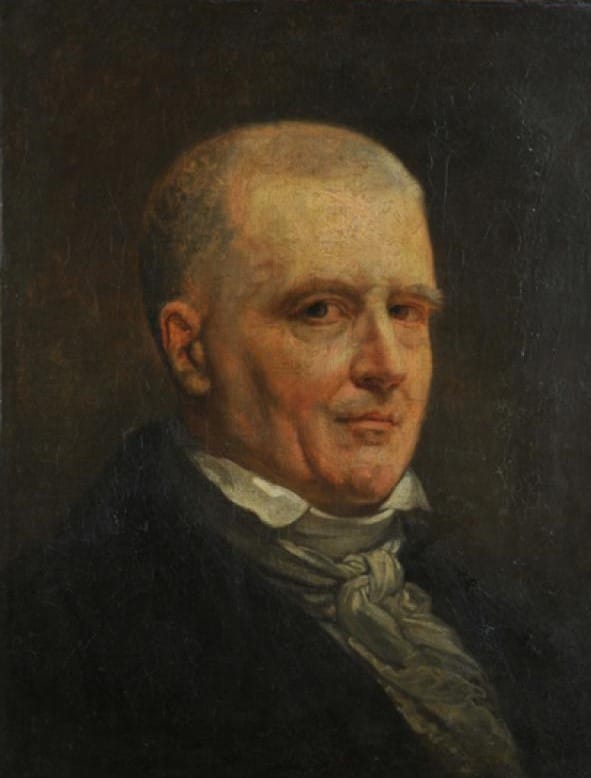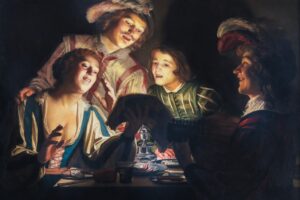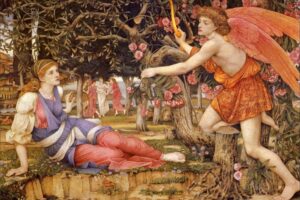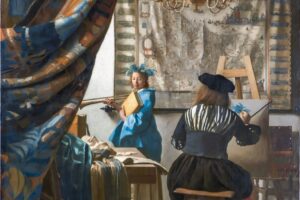A Garden Full of Charm: Fragonard’s The Musical Contest
Imagine a golden afternoon in a secluded garden, where music fills the air, laughter is shared, and hearts are light. That’s the magical feeling captured in The Musical Contest, a delightful painting created around 1754–1755 by Jean-Honoré Fragonard, one of the great painters of the Rococo era.
Fragonard was a student of François Boucher and carried on the Rococo tradition with his own joyful, light-filled style. His paintings often show flirtation, play, and the sweetness of young love—set in dreamy outdoor scenes like this one.
What’s Happening in the Painting?
At the center of this garden gathering sits a young woman dressed in rich pink and white. She holds a garland of flowers and a bright yellow parasol, which makes her instantly stand out in the scene. Her confident, playful expression and upright posture suggest she’s the one being serenaded—perhaps the judge in this friendly “contest.”
Two young men sit close to her, each hoping to win her attention through music.
- The Flute Player sits to the left, holding a small flute. His elegant clothing and rosy cheeks give him a refined look. He may have just finished playing a tune, waiting for her reaction.
- The Birdsong Imitator, kneeling on the right, is closer and more animated. He seems to be either whistling or using a birdcall—perhaps a musical toy or a small bird flute common in 18th-century courtship rituals. His act of mimicry adds humor and tenderness to the scene.
This isn’t a fierce competition. It’s more like a charming performance—a playful game of attraction and delight.
A Garden Full of Story
Look closer and you’ll notice all kinds of lovely details:
- Nature’s Touch: Behind them, trees form a leafy canopy, giving the scene a sense of privacy and softness. A stone fountain on the left adds a sense of timeless beauty, overgrown with greenery and decorated with carved figures—perhaps suggesting Cupid or other mythological beings.
- Signs of Leisure: Scattered at their feet are little touches of everyday pleasure—ribbons, hats, musical instruments, and a basket full of fruit. These clues tell us this wasn’t a quick visit but a whole afternoon of joy.
- The Atmosphere: Everything is lit by soft, golden light. The colors are warm and pastel, from the gentle blue of the sky to the soft pinks, yellows, and greens of their clothing and surroundings. Fragonard’s brushwork makes everything feel alive and glowing.
The Spirit of the Painting
The Musical Contest doesn’t tell a deep or serious story—it tells a lighthearted one. It celebrates beauty, music, nature, and affection. It captures a timeless moment of flirtation and fun, where no one really wins or loses, and everyone is caught in the joy of the moment.
Fragonard invites us to pause, smile, and enjoy a world where life is graceful, tender, and full of charm. Just like the Rococo era itself, this painting reminds us that sometimes the best things in life are the simplest: a song, a smile, a flower, and a warm sunny day.
About Artist

Jean-Honoré Fragonard (1732–1806) was a French painter and printmaker who is considered one of the leading figures of the Rococo art movement. His style is a vibrant and fluid expression of the late Rococo, known for its lightheartedness, sensuality, and free-flowing brushwork. Unlike his contemporary Boucher, whose work could sometimes feel more formal, Fragonard’s paintings have a spontaneous and energetic quality that perfectly captured the spirit of the French aristocracy on the eve of the revolution.
Artistic Style and Legacy
Fragonard was a student of François Boucher, and he inherited his master’s love for mythological and pastoral themes. However, Fragonard’s style is more dynamic and painterly, with a liveliness all his own. His work is characterized by:
- Energetic Brushwork: His brushstrokes are visible and expressive, creating a sense of movement and spontaneity.
- Lush, Luminous Color: He used a rich and glowing palette, with shimmering whites, rose, and gold.
- Playful Sensuality: He often depicted scenes of romantic trysts, playful games, and idyllic moments of love, with a light and often erotic touch.
Fragonard’s art fell out of fashion during the Neoclassical period, which favored more serious, moralizing subjects. He died in obscurity, but his reputation was revived in the 19th century, and he is now celebrated as a master of the Rococo.
Artwork Profile
All of the paintings you mentioned are indeed by Jean-Honoré Fragonard. They are excellent examples of his style and a testament to his genius.
- The Swing (c. 1767): This is arguably Fragonard’s most famous painting and a quintessential work of the Rococo period. It depicts a young woman on a swing, with her suitor hiding in the bushes below, catching a glimpse of her as she kicks off her shoe. The lush, overgrown garden, the playful sensuality, and the charming narrative make it an icon of the era.
- The Lover Crowned (c. 1771-1772): Part of a famous series known as “The Progress of Love,” this painting shows a young woman crowning her lover with a wreath of flowers. The scene is filled with a sense of joyous, unrestrained romance.
- The Musical Contest (c. 1754): An early work from his Italian period, it shows a group of young people engaged in a musical game, demonstrating his early interest in playful social scenes.
- The Shepherdess (c. 1760): A charming example of his pastoral scenes, it depicts an idealized country girl in a beautiful, natural setting.
- Blind Man’s Buff (c. 1750-1752): Fragonard painted a few versions of this popular game. The one in the National Gallery of Art is a lively, outdoor scene full of energy and flirtation.
- The Happy Lovers (c. 1765): A beautiful and tender portrayal of a young couple, it perfectly captures the idealized, amorous mood of his mature style.



